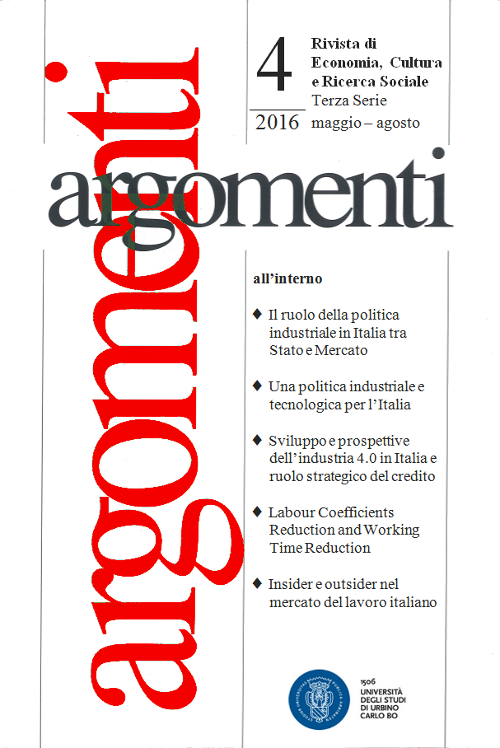Abstract
In this paper we have tried to describe the main challenges and opportunities that the transition to the fourth industrial revolution involves, focusing on the impact on business models and supply chains. As shown by some surveys, almost all Italian companies are still unprepared to face the new challenge and are likely to start with a severe handicap compared to foreign competitors. The banks, that are the main source of financing for Italian firms, have to play a very important role in this historic transition. However, the European comparison shows that the financing of Italian corporate companies absorbs more bank capital than corporate companies of other European countries, like Germany. Then it’s important to strengthen the government guarantees schemes, freeing capital for banks and facilitating the access to the Central Guarantee Fund even by Mid Caps (the firms from 250 to 500 employees). Even now in some European countries such as Germany the access to government guarantees schemes covers medium and large companies. The greater use of this tool is desirable both for banks and for businesses.
Riferimenti bibliografici
Arrighetti, A., Ninni, A. (2014). Cambiamento dei sistemi manifatturieri e percorsi evolutivi delle imprese italiane. In A. Arrighetti e A. Ninni (a cura di), La trasformazione “silenziosa” (pp. 5-49). Dipartimento di Economia Università di Parma. Collana di Economia Industriale e Applicata.
Banca d’Italia (2015). Relazione annuale sul 2014.
Banca d’Italia (2016). Bollettino Statistico I-2016.
Bianchi, P. e Labory, S. (2016). Towards a new industrial policy. Milano. McGraw Hill Education.
Brynjolfsson, E., McAfee, A. (2015). La nuova rivoluzione delle macchine. Lavoro e prosperità nell’era della tecnologia trionfante. Milano. Feltrinelli.
Confindustria (2015). L’Industria 4.0: stato dell’arte, prospettive e implicazioni. In Produzione e commercio: come cambia la globalizzazione. La manifattura italiana riparte su buone basi. Scenari Industriali.
Commissione Europea (2016). Report from the commission to the european parliament and the council on the quality of fiscal data reported by Member States in 2015
De Nardis, S. (2015). Manifattura. Rivista di Politica Economica, 1-3: 313-360.
European Banking Authority (2013). http://www.eba.europa.eu/risk-analysis-and-data/eu-wide-stress-testing/2014/results
Eurostat (2015). First time release of data on contingent liabilities and non-performing loans in EU Member States.
Ferri, G. (2015). Vincoli di capitale nell’erogazione del credito alle piccole e medie imprese e ruolo strategico delle garanzie pubbliche. Presentazione in UniCredit, 2 dicembre.
Gambuli, P., Mariotti, A., Rotondi, Z. (2012). La filiera della meccanica industriale. Bari. Editori Laterza.
KPMG (2014). Rapporto Mergers&Acquisitions.
Picchio, N. (2016). Far ripartire gli investimenti. “Il Sole 24Ore”, 28 gennaio.
Promuovitalia (2014). Rapporto di Approfondimento sul Fondo di Garanzia.
Prometeia (2016). Industria e filiere 2016. Tra rischi e ripresa. Gennaio.
Ocse (2015). Financing Smes and entrepreneurs 2015, an Oecd scoreboard
Rifkin J. (2016). The 2016 World Economic Forum Misfires With Its Fourth Industrial Revolution Theme. In Huffington Post, 14 gennaio.
Roland Berger (2014). Industry 4.0 The new industrial revolution. How Europe will succeed, Think Act.
Schwab, K. (2015). The Fourth Industrial Revolution. Foreign Affairs, 12 dicembre.
Sedezzari, L. (2014). La politica industriale e gli strumenti di finanziamento dell’UE per le PMI ai fini di una reindustrializzazione dell’Europa. Argomenti, 41, 91-121. doi: 10.3280/ARG2014-041005
Staufen (2015). Industria 4.0 Sulla strada della fabbrica del futuro. Qual è la situazione dell’Italia?
Staufen (2015). Industria 4.0: un confronto internazionale.
World Economic Forum (2016). The Future of Jobs. Employment, Skills and Workforce Strategy for the Fourth Industrial Revolution.
L'opera è pubblicata sotto Licenza Creative Commons - 4.0 International (CC BY 4.0)





